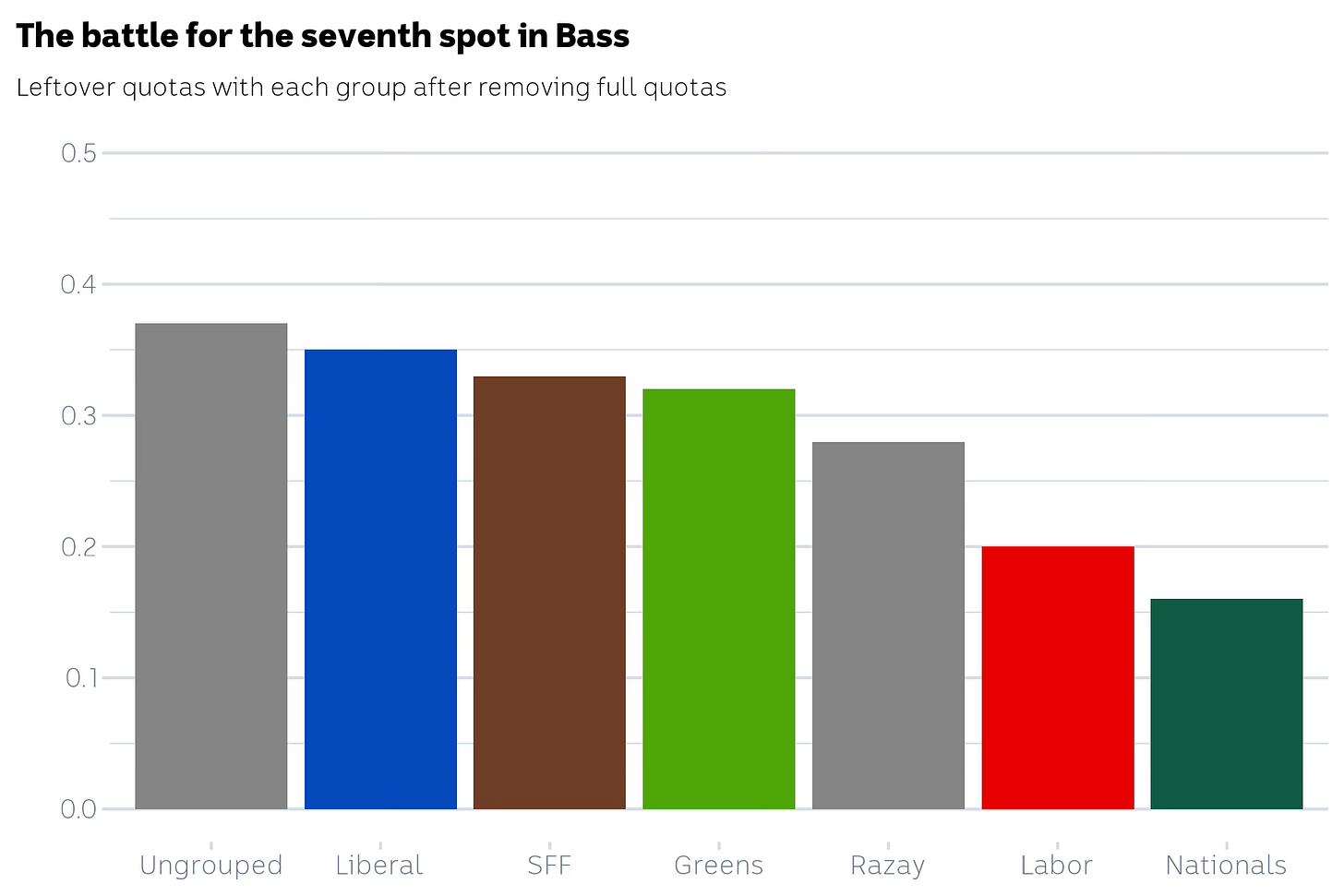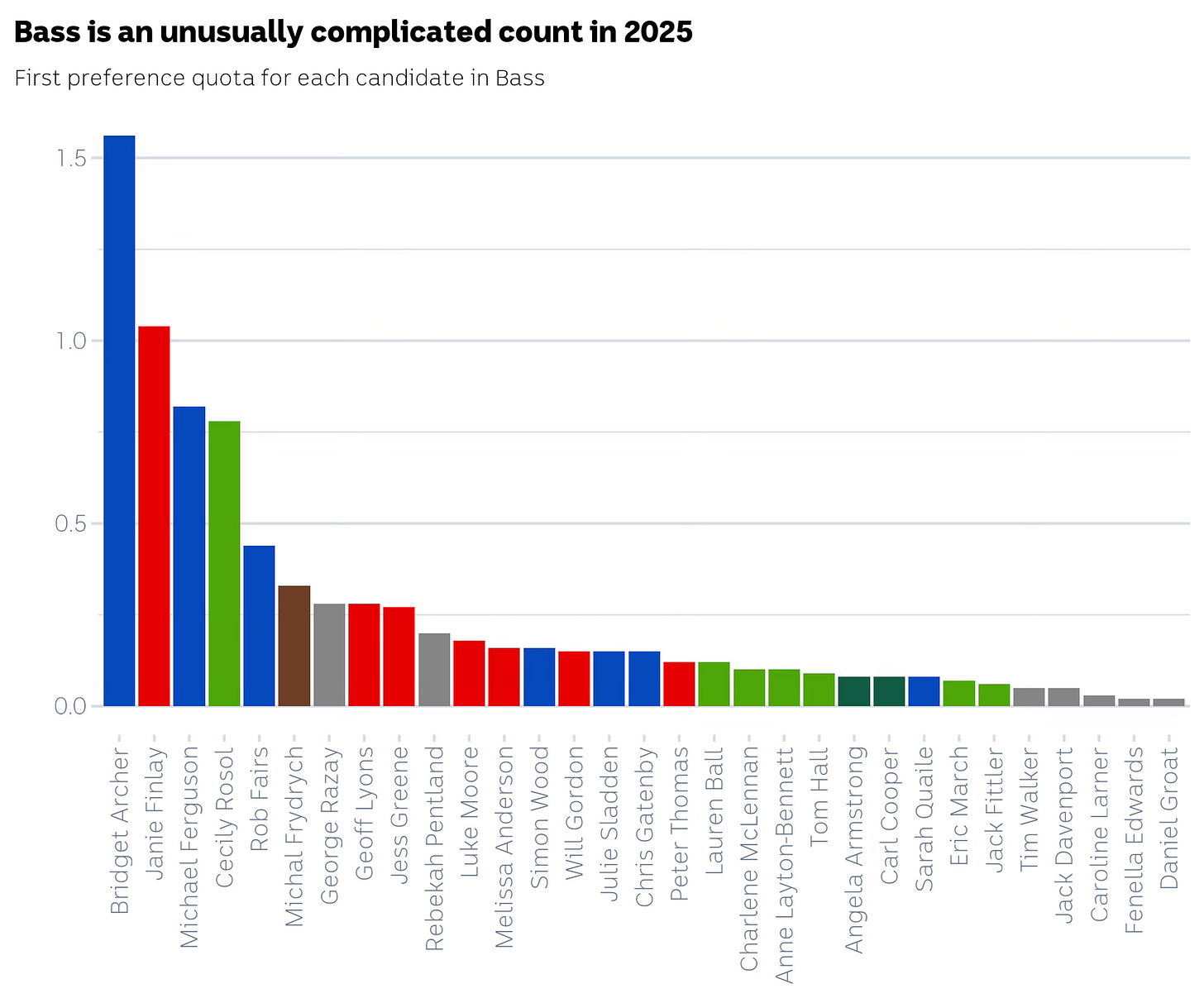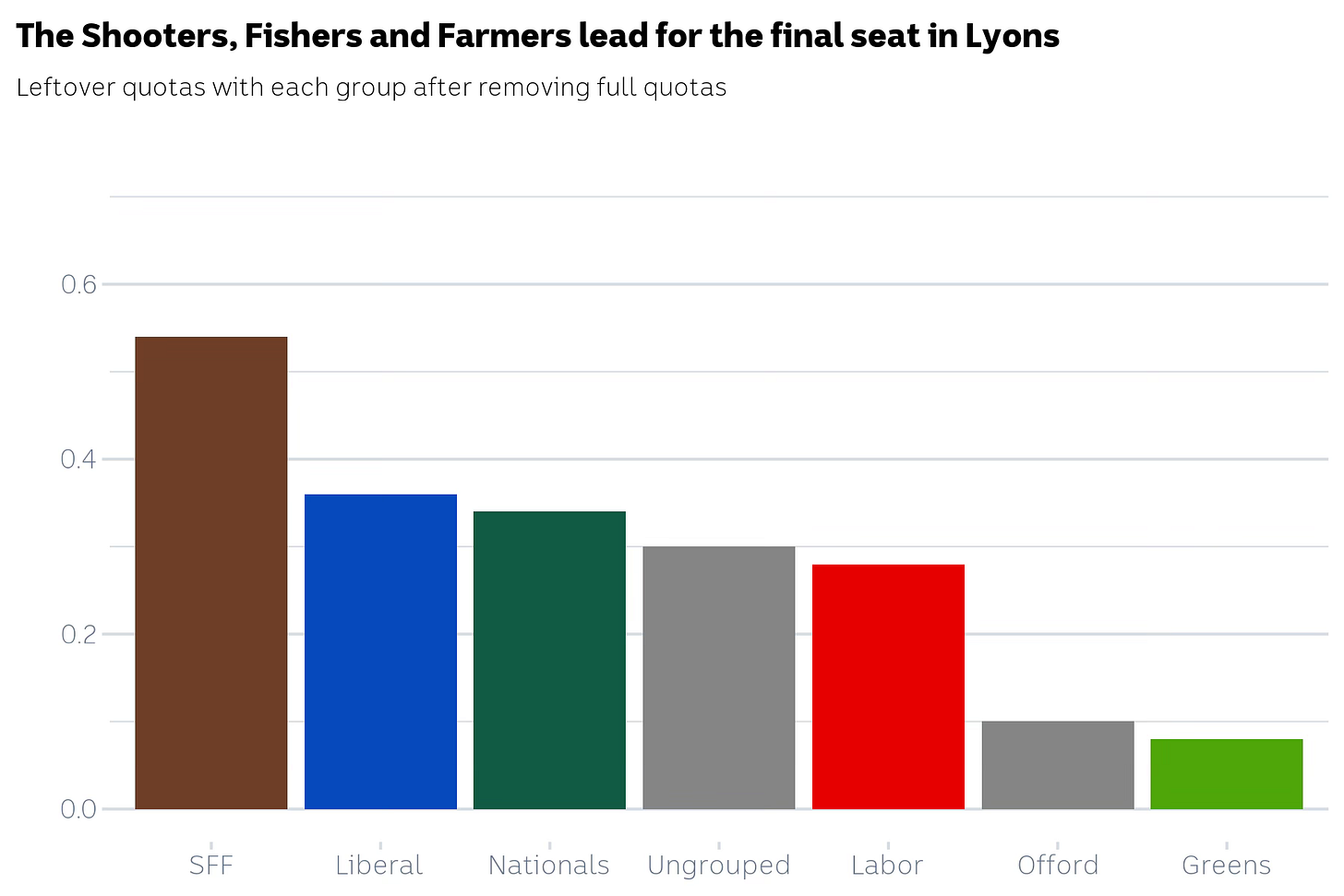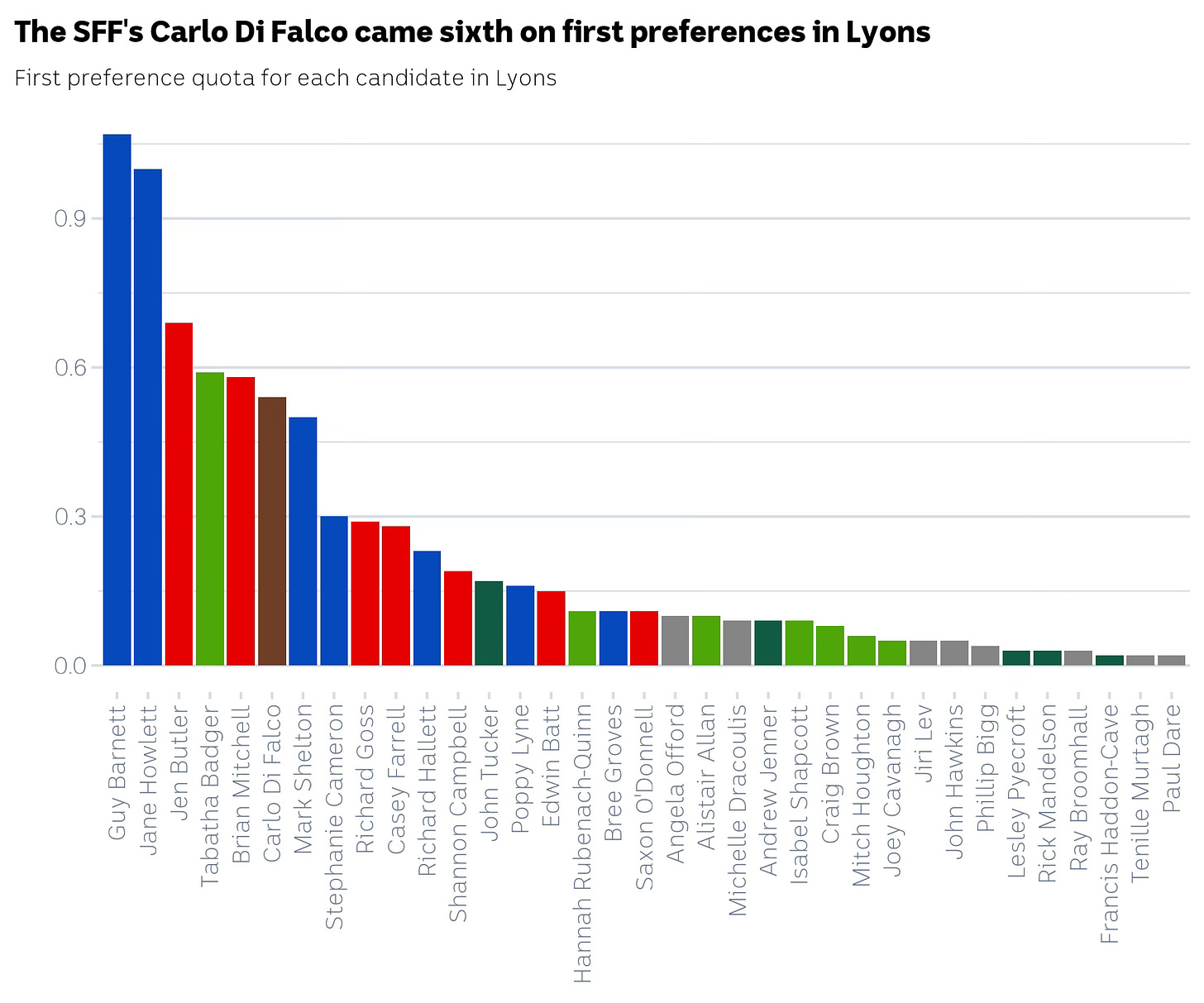Tasmania has reached the pointy end of the election count
You get excluded! You get excluded! You get excluded! Everybody (except for seven of you) get excluded!
After days of counting and an extended wait for all the postal votes to be received, we’re about to get some more clarity on the outcome of the Tasmanian state election.
Of the 35 seats in state parliament, there’s still doubt over which party will hold two: the final seat in Lyons and the final seat in Bass. I’ll do a quick state of play on those two in a moment. There are also a handful of seats in which it’s clear which party will win but not necessarily which individual candidate is on their way to the House of Assembly.
Will Geoff Lyons or Jess Greene win Labor’s second seat in Bass? Can they both win? Will Liberal Simon Behrakis maintain his position ahead of his colleague Madeleine Ogilvie in Clark? One of the two sitting members will be defeated.
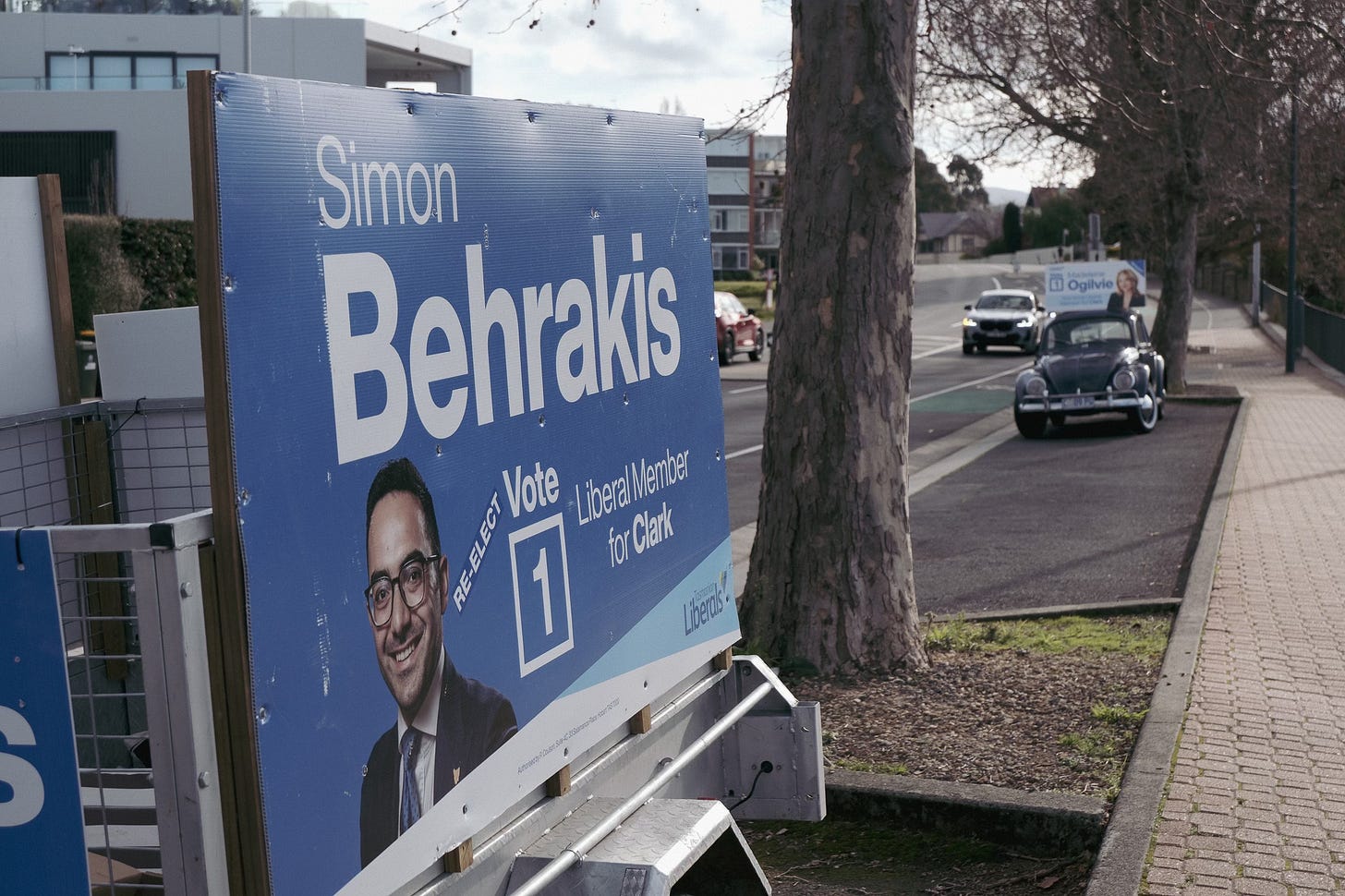
Candidates’ appointed scrutineers have had a fair bit of time to look at votes and get a sense of where preferences are flowing, so there are some scraps of information floating around, but from tomorrow we’ll see the actual figures.
Here’s how the rest of the count will go:
The deadline for postal votes to be returned is 10am Tuesday. At that point the commission will add any final votes (plus a small handful they’ve withheld from the count to preserve the secrecy of votes) and produce final first preference figures.
From there, any candidate who has individual exceeded a quota (one-eighth of the vote) will have their surpluses distributed (of particular interest here will be the surpluses of Jeremy Rockliff and Bridget Archer, and I’m also interested to see who Peter George and Kristie Johnston voters ranked)
Then, while there are no candidates over a quota, candidates will be excluded and distributed one at a time, in order of their vote from bottom to top.
The Tasmanian Electoral Commission has already done a preliminary sorting of the preferences for those candidates with a surplus, and so we might find the first few rounds of distributions happen quite quickly tomorrow afternoon.
It’ll slow down after that as staff meticulously exclude candidates one by one.
The TEC is hoping to have it all wrapped up by Saturday, but if it goes slowly it could run into early next week.
Bass
This is a particularly fascinating and complicated count with a lot of moving parts. With 3.35 quotas, the Liberal Party is certain to win three seats, Labor will win two from 2.2 quotas, and the Greens have one from 1.3 quotas.
Who will win the seventh? The general consensus is: ¯\_(ツ)_/¯
This is a gross simplification of Hare-Clark, but to illustrate who is in this contest, take a look at the ‘leftover’ quotas each group has (after we remove the full quotas that elect the first six members)
Setting aside the vote for ungrouped independent candidates (about half of that is Rebekah Pentland with the remainder spread between five other independents), the Liberal Party has the single highest leftover vote. There are seemingly also more conservative-leaning votes in the mix than progressive ones.
But the Liberal ticket is more prone to leakage than the others, because Bridget Archer has more than 1.5 quotas.
Leakage occurs when a voter’s preferences leave a party’s ticket, and it can be more commonly seen when a candidate has a very high profile. In this case, given her name-recognition and reputation as a maverick in federal parliament, it could be that a significant number of people have voted for Bridget Archer but then left that column and ranked candidates from other parties.
There have been reports from scrutineers that Bridget Archer’s votes will leak more than a usual Liberal candidate, and if they do it would hurt the party’s chances of winning a fourth seat here.
The SFF cannot leak votes because it only ran one candidate in Bass. Could that party win some preferences from Nationals voters and leapfrog over the Liberal Party? We’ll have to wait and see.
Labor is less vulnerable to leakage because of their lower vote and the fact that they have two candidates in the mix on roughly similar votes, who will survive in the count for a long while.
The Greens column above is bigger than Labor’s, but the distribution of its votes across candidates is far less useful than the opposition’s, as you can see in the chart below which shows all candidates in order of primary vote. The last Labor candidate has a higher vote than the second Greens candidate.
Theoretically, independent George Razay has a chance too, given he starts in seventh place. Like the SFF, he can’t leak, but it’s unclear that he’d attract many preferences.
The order of candidates will shift a bit through the count as preferences get transferred, but this chart is a loose guide to the order of elimination this week.
It is entirely possible Labor’s third candidate stays ahead and this seat becomes a battle between Labor and either the Liberal Party or SFF.
For Labor, this would be their only gain in this election (even though the party lost votes, including in Bass) and an important win in their attempt to cobble together a government.
But there are too many moving parts to be confident on this one.
Lyons
This is another interesting count, but in this case the contest does have a clearer frontrunner, so let’s keep this one briefer.
The SFF’s Carlo Di Falco, who is no stranger to Tasmanian elections, appears well placed to win this seat. However, it’s not impossible for another candidate (most likely a Liberal) to catch him.
As you can see, he’s well ahead of the other parties after removing the six quotas that will elect other candidates (3 Liberal, 2 Labor, 1 Green).
He’s also the only SFF candidate in Lyons, meaning he can’t lose votes to leakage.
Here are the primary quotas for each candidate:
Labor’s not in a great position to win three, because it starts well behind and has two clear leaders who are still well short of quota. Jen Butler and Brian Mitchell are likely to absorb many of the Labor preferences and deprive a third candidate the chance of overtaking the SFF. Similarly, most of the votes with the Greens’ lower candidates are going to roll up into Tabatha Badger.
It’s easier to see a world where a fourth Liberal candidate survives and this becomes a race between the Libs and the SFF.
Regardless, the most likely scenario here is that this seat remains with a more conservatively-minded party.
Meanwhile, the other contest rages
Both sides are continuing to do the numbers on formation of government (luckily you only need to be able to count to 18 to keep track of this one). With the negotiations in something of a holding pattern, the major parties are trying to win two battles: convince cross benchers to side with them, and win the battle of legitimacy in the court of public opinion.
Kevin Bonham spotted that the Liberal Party is now running ads attacking Labor and the idea that they’d form government with the support of the Greens.
A bit of digging in the digital ad libraries shows these ads started running on YouTube on Friday and are now on Meta too. It’s not a massive spend, but given Jeremy Rockliff’s confidence on election night and the Liberal Party’s call for Dean Winter to concede defeat last week, it’s interesting to see the party acknowledge and contest the idea that things may not end up going their way.
The Facebook ad copy reads:
“Labor's worst vote for over 100 years. Now they're breaking their promise of not doing a deal with the Greens.”
Here’s the ad running on YouTube. It has had roughly 150K impressions across Tasmania.
Neither Tasmanian Labor nor the Tasmanian Greens haven’t launched a new ad on Google or Facebook since election day.
In other election news
A by-election is likely in the NSW state seat of Kiama, with the government and opposition both backing a plan to expel MP Gareth Ward from parliament after his convictions for serious sexual offences last week. Parliament next sits on Tuesday August 5.
A group of 24 members of parliament in Taiwan have survived a recall election brought on by campaigners who viewed them as being too pro-China. They’re all members of the main opposition party Kuomintang (KMT), a group that wants closer ties with Beijing. The election was supported by President Lai Ching-te's Democratic Progressive Party, and the result could have given her party control of the parliament. Recall votes will be held over seven more KMT members next month.
Bolivia goes to the polls next month. There are nine candidates running for President and no one seems to have the support of more than a quarter of voters. The current president Luis Arce is not running, saying in his announcement that “I will not be a factor in dividing the popular vote, much less facilitate the making of a fascist right-wing project that seeks to destroy the plurinational state”. There’s been a schism in the governing party that’s seen Arce and former president Evo Morales turn from allies to rivals. Last year Arce’s army general led an unsuccessful coup, and Morales is talking about seeking a fourth term as president, despite the country’s constitutional court upholding a two-term limit. He also ran for a fourth term in 2019 but fled the country after that disputed election. Look, it’s complicated.




